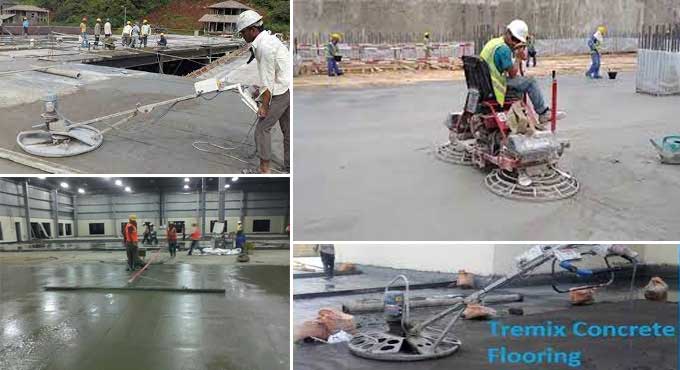
Tremix Flooring with its various concept and procedures

Tremix flooring, also known as Vaccum Dewatering flooring, is a special kind of flooring that is mostly used in the industrial sector.
It is used for machine foundations, light load carrier vehicles, and lightweight cranes where a hard surface is required. According to the flooring's thickness, Tremix concrete flooring provides the necessary support.
Tremix Flooring- Definition
Tremix flooring is a unique kind of floor covering that is mostly used in the industrial sector. It has improved tearing and wearing characteristics. It is often used for industrial purposes when a hard surface is required for the foundation of machines, light load carriers, and light cranes.
Tremix typically uses a concrete mix of the following specifications: 1 cement, 1.5 sand, and 3 stone aggregates, with a richer 1:1:2 mix, often recommended for better wear and tear. The thickness of the flooring determines how much reinforcement is needed in this flooring, which ranges from 100 to 200 mm over PCC (1:4:8) and 230 to 300 mm over a well-prepared stone sub-base.
For heavy-duty locations like warehouses, garages, and machine shops, a PCC foundation up to 100 mm and floor concrete 150 mm thick is recommended for industrial flooring.
Instruments this Tremix flooring demands
The following are the tools and supplies required for trimix flooring:
1. Pump for vacuum dewatering.
2. Floater device.
3. Skin Tremix.
4. Double Beam Screed Vibrating Machine.
Proper Tremix flooring techniques you may want to know
1. By wetting and pounding the sub-base, make sure there is no remaining loose debris. Lay 230 mm to 300 mm of material on a level surface, and specific measurement of thick stone or boulder soling layer must be present and adequately compacted.
2. PCC construction, which must be installed over stone soling, must preserve a floor slope. PCC must not be any thicker than 100 mm.
3. Tremixing must be done in modules, each of which must be 3.5 meters long. The adequate reinforcing bar must be installed in layers of two or one, with a concrete cover of 50 meters.
4. Machines that vacuum away surplus water from the top layer of wet concrete without removing the cement or sand particles are helpful. When the concrete is still new, this is done just after concerting, ramming, or vibrating with a screed vibrator, and leveling the first round of troweling.
5. It will not only boost the concrete's strength but also the floor's resistance to abrasion. It is also always a good idea to apply a hardener to increase the floor's resistance to abrasion when finishing the floor's surface with a floater machine. Using this approach also reduces shrinkage fractures.
6. Additionally, a little quantity of floor hardener and polyurethane fibers must be added to concrete in order to prevent shrinkage cracks and promote abrasion. The producers must specify how much fiber and bonding agent to use.
7. When vast areas need to be floored, casting concrete flooring in panels to prevent shrinkage cracks and serve as expansion joints is a laborious and time-consuming procedure. Without any building joints, the concrete is laid down in panels. After 7 to 10 days, when the concrete has not completely cured, panel joints must be cut using a cutting saw. In order to close the gap, sealants or polysulfide are used.
A few Possible benefits of using this Tremix Flooring concept
Following are a few major benefits of using a Tremix flooring concept:-
1. Comparing vacuum dewatering floors to traditional PCC floors, the former has greater compressive strengths.
2. Faster Initial Strength is offered by Tremix Flooring.
3. Crack Tremix Reduced Shrinkage.
4. Reducing Permeability.
5. Improve the floor's resistance to abrasion.
To learn more, watch the following video tutorial.
Video Source: Factual Civil Engineering
A few possible drawbacks of using this Tremix Flooring concept
Following are a few major drawbacks of using a Tremix flooring concept:-
1. An initial investment that is high.
2. The procedure of vacuum dewatering requires skilled manpower.
3. Vacuum dewatering requires specialized equipment, such as a vacuum pump.
4. Power use is necessary during the dewatering process.


